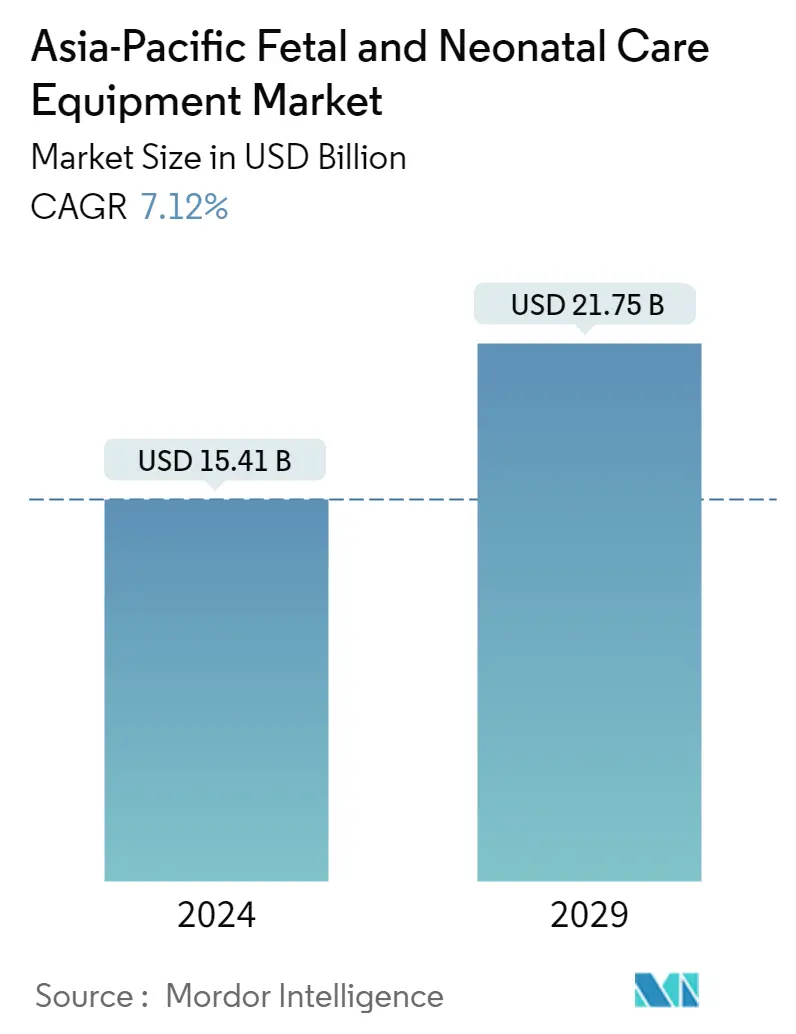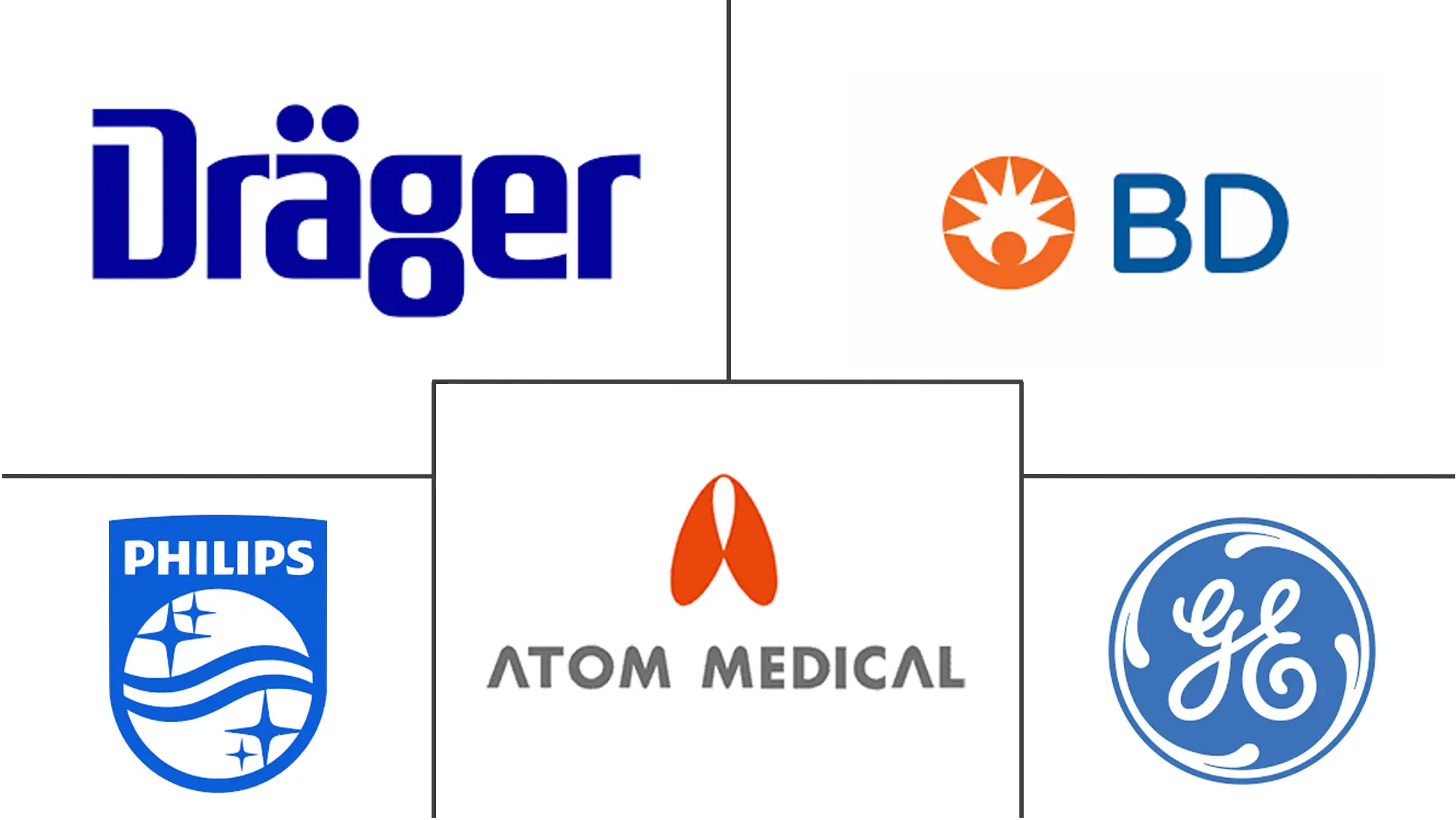Market Size of Asia-Pacific Fetal and Neonatal Care Equipment Industry

| Study Period | 2019 - 2029 |
| Base Year For Estimation | 2023 |
| Forecast Data Period | 2024 - 2029 |
| Market Size (2024) | USD 15.41 Billion |
| Market Size (2029) | USD 21.75 Billion |
| CAGR (2024 - 2029) | 7.12 % |
Major Players
*Disclaimer: Major Players sorted in no particular order |
Asia-Pacific Fetal and Neonatal Care Equipment Market Analysis
The Asia-Pacific Fetal and Neonatal Care Equipment Market size is estimated at USD 15.41 billion in 2024, and is expected to reach USD 21.75 billion by 2029, growing at a CAGR of 7.12% during the forecast period (2024-2029).
The global pandemic of COVID-19 is predicted to have an impact on the market for fetal and neonatal care equipment. Pregnant women should have routine prenatal checks at 12, 20, 28, and 36 weeks of pregnancy, according to the Indian Council of Medical Research (ICMR) guidelines from 2020, unless they meet the self-isolation criteria. Appointments for women who have had COVID-19 symptoms can be postponed until seven days after the onset of symptoms unless the symptoms become severe. During the COVID-19 outbreak, according to an article published in the BMJ Journal in November 2020 by experts from the University of Tokyo, there was a dramatic decline in the number of intensive newborn care across Japanese acute care hospitals. The study also observed a drop in the number of preterm births (before 34 gestational weeks and between 34-37 gestational weeks). However, as the population has begun to cope with the pandemic, regular prenatal checkups and neonatal care is expected to boost, which is expected to significantly impact the market.
The key contributors to the market growth are the increasing number of preterm births and the technological advancements in care equipment. There was a significant regional divide between countries in eastern Asia (such as China and the Republic of Korea) and southern Asia (Bangladesh, India, Nepal, Pakistan, and Sri Lanka). China had the lowest low birth weight rate at 2.3%, while Pakistan reported a rate of 31.6%.
The technological advancements in infant and maternal care products are also a major driver for the growth of the market. Many technologies that monitor an infant's and the mother's vital signs like heartbeat are being used in rural areas where access to advanced hospital care is missing. For example, in November 2021, Abdul Latif Jameel General Trading Co. and Melody International collaborated for the distribution of Melody's innovative iCTG remote fetal monitor, a cloud-based mobile wireless fetal monitoring platform. A study published in the Journal of Pediatrics in 2020 found that nearly 6.2% of infants born with very low birth weight in Japan had birth defects such as chromosomal abnormalities, congenital heart defects, congenital malformation of the digestive system, Trisomy 18, Down syndrome, and cleft palate. Better outcomes necessitate genetic counseling and prenatal and neonatal care. As a result, the rising prevalence of preterm births and the introduction of novel technologies in the industry are likely to propel the Asia-Pacific fetal and neonatal care equipment market forward during the forecast period.
Asia-Pacific Fetal and Neonatal Care Equipment Industry Segmentation
Fetal and neonatal care equipment are tools that are routinely used in gynecology and obstetrics interventions to examine fetal health during labor and delivery. Neonatal devices are extensively used in neonatal intensive care units (NICUs), where complex machines and monitoring devices are designed for the unique needs of newborn babies.
The Asia-Pacific fetal and neonatal care equipment market is segmented by product (fetal care equipment [fetal dopplers, fetal magnetic resonance imaging (MRI) devices, ultrasound devices, fetal pulse oximeters, and other fetal care equipment] and neonatal care equipment [incubators, neonatal monitoring devices, phototherapy equipment, respiratory assistance and monitoring devices, and other neonatal care equipment]) and geography (China, Japan, India, Australia, South Korea, and Rest of Asia-Pacific). The market report also covers the estimated market sizes and trends for 17 different countries across the major regions globally. The report offers the value (in USD million) for all the above segments.
| Product | |||||||
| |||||||
|
| Geography | |
| China | |
| Japan | |
| India | |
| Australia | |
| South Korea | |
| Rest of Asia-Pacific |
Asia-Pacific Fetal and Neonatal Care Equipment Market Size Summary
The Asia-Pacific fetal and neonatal care equipment market is poised for significant growth, driven by an increasing number of preterm births and advancements in medical technology. The market is characterized by a moderate level of competition, with key players such as Atom Medical Corporation, Beckton, Dickinson and Company, and GE Healthcare actively engaging in strategies like acquisitions and product launches to enhance their market presence. The demand for neonatal care equipment, including incubators, is bolstered by the high prevalence of conditions such as premature birth and low birth weight, particularly in countries like India and Pakistan. Technological innovations, such as remote fetal monitoring systems, are expanding access to essential care in rural areas, further propelling market growth.
The impact of the COVID-19 pandemic has been notable, with initial declines in prenatal and neonatal care, but a resurgence is expected as the population adapts to the new normal. The Chinese market, in particular, is anticipated to experience robust growth due to increased awareness of fetal care and a rising incidence of preterm births. Ongoing developments in fetal and neonatal care equipment, coupled with the introduction of novel technologies, are set to drive the market forward. The region's market dynamics are influenced by a mix of demographic factors, healthcare infrastructure, and technological advancements, positioning it for continued expansion over the forecast period.
Asia-Pacific Fetal and Neonatal Care Equipment Market Size - Table of Contents
-
1. MARKET DYNAMICS
-
1.1 Market Overview
-
1.2 Market Drivers
-
1.2.1 Increasing Number of Preterm and Low-weight Births
-
1.2.2 Growing Technological Advancement in Infant and Maternal Care Products
-
1.2.3 Increase in the Prevalence of Congenital Anomalies
-
-
1.3 Market Restraints
-
1.3.1 High Prices of Advanced Neonatal Care Equipment
-
-
1.4 Porter's Five Forces Analysis
-
1.4.1 Threat of New Entrants
-
1.4.2 Bargaining Power of Buyers/Consumers
-
1.4.3 Bargaining Power of Suppliers
-
1.4.4 Threat of Substitute Products
-
1.4.5 Intensity of Competitive Rivalry
-
-
-
2. MARKET SEGMENTATION
-
2.1 Product
-
2.1.1 Fetal Care Equipment
-
2.1.1.1 Fetal Dopplers
-
2.1.1.2 Fetal Magnetic Resonance Imaging (MRI) Devices
-
2.1.1.3 Ultrasound Devices
-
2.1.1.4 Fetal Pulse Oximeters
-
2.1.1.5 Other Fetal Care Equipment
-
-
2.1.2 Neonatal Care Equipment
-
2.1.2.1 Incubators
-
2.1.2.2 Neonatal Monitoring Devices
-
2.1.2.3 Phototherapy Equipment
-
2.1.2.4 Respiratory Assistance and Monitoring Devices
-
2.1.2.5 Other Neonatal Care Equipment
-
-
-
2.2 Geography
-
2.2.1 China
-
2.2.2 Japan
-
2.2.3 India
-
2.2.4 Australia
-
2.2.5 South Korea
-
2.2.6 Rest of Asia-Pacific
-
-
Asia-Pacific Fetal and Neonatal Care Equipment Market Size FAQs
How big is the Asia-Pacific Fetal and Neonatal Care Equipment Market?
The Asia-Pacific Fetal and Neonatal Care Equipment Market size is expected to reach USD 15.41 billion in 2024 and grow at a CAGR of 7.12% to reach USD 21.75 billion by 2029.
What is the current Asia-Pacific Fetal and Neonatal Care Equipment Market size?
In 2024, the Asia-Pacific Fetal and Neonatal Care Equipment Market size is expected to reach USD 15.41 billion.

